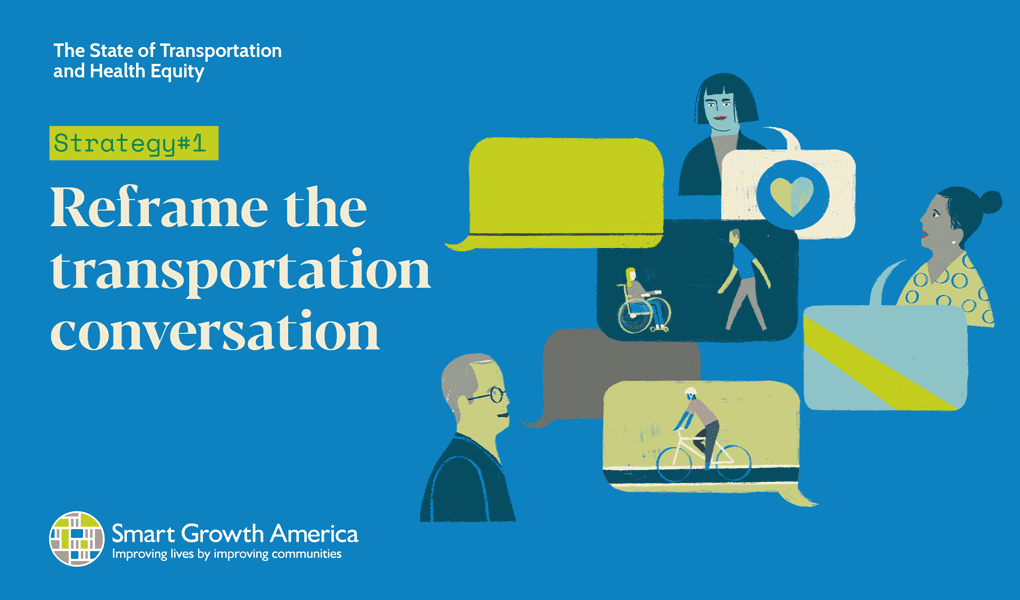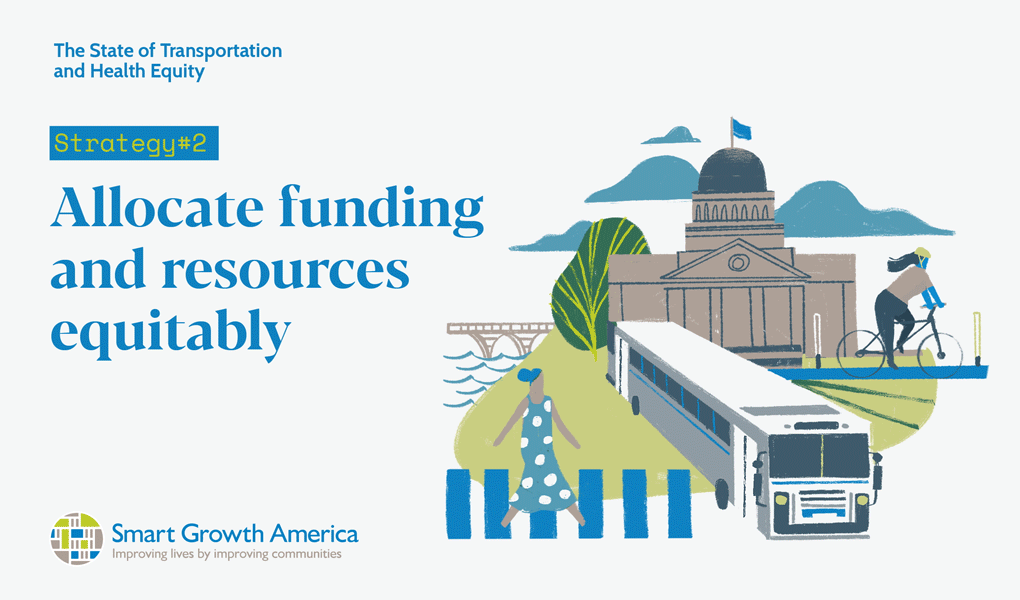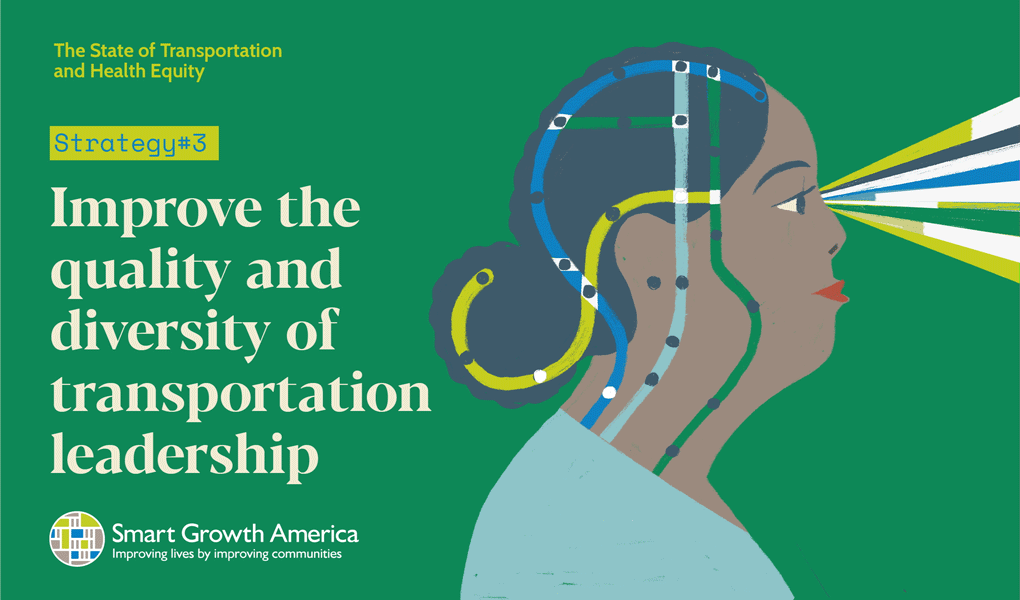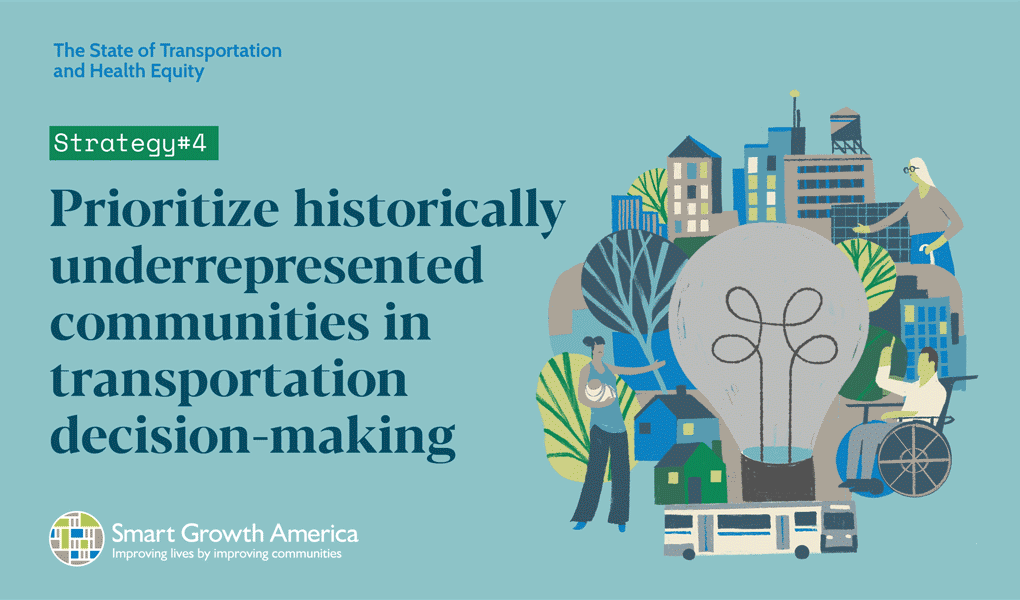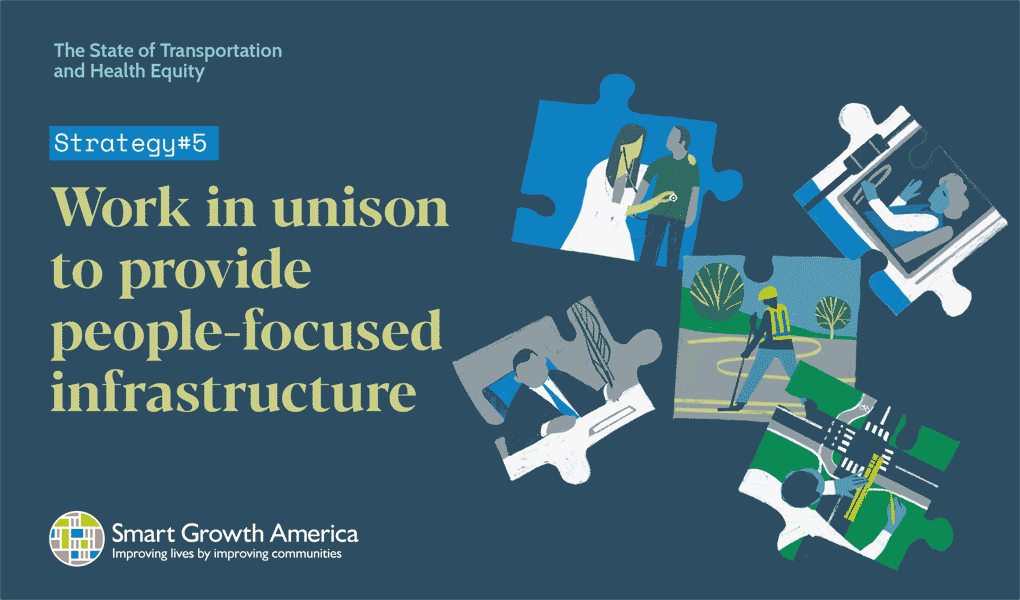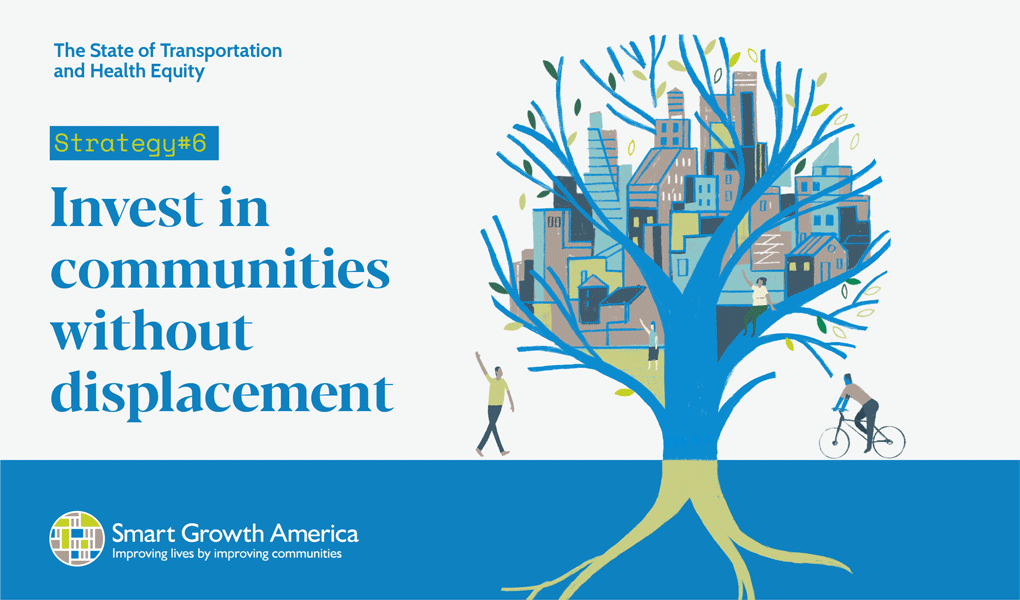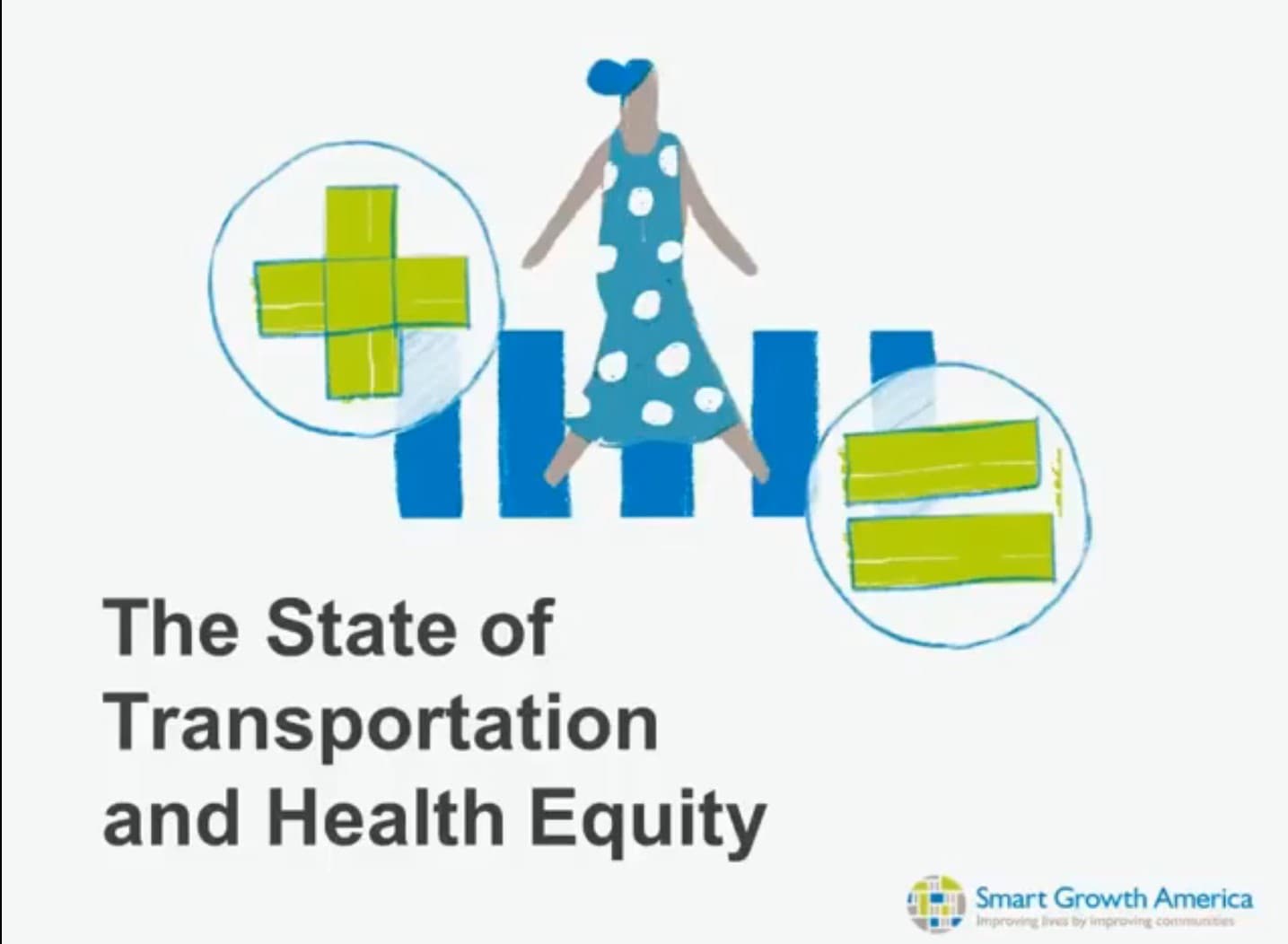
News
By Mae Hanzlik, February 21, 2020
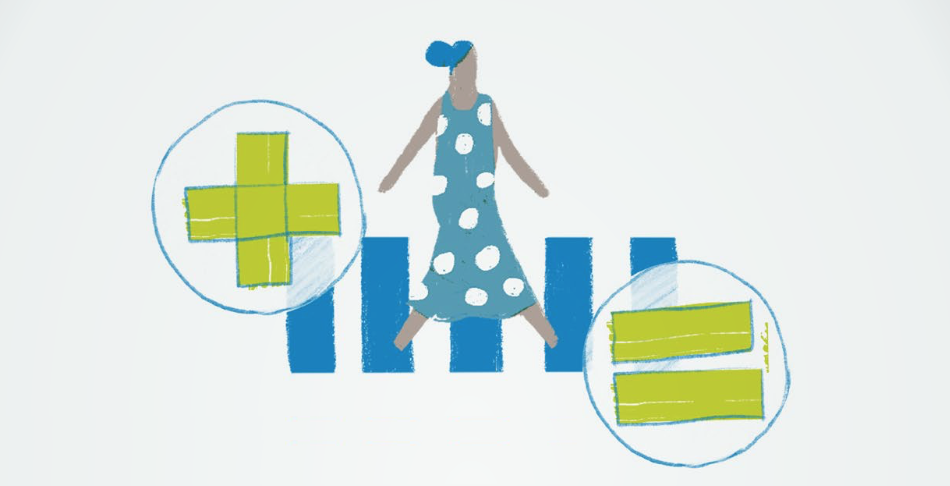
Smart Growth America recently released The State of Transportation and Health Equity, a field scan looking at the intersection of transportation and health equity in the U.S. today. Last month, Emiko Atherton walked through the high-level findings on a webinar. A recording of the webinar with closed captioning is now available. You can also download a PDF of the presentation or read the brief recap below.
What is health equity?
Emiko Atherton, Director of the National Complete Streets Coalition and Vice President of Smart Growth America (SGA), kicked off the webinar by defining health equity—a term that can sometimes mean different things to different people. For the sake of this report, SGA used Robert Wood Johnson Foundation’s definition: “Health equity means that everyone has a fair and just opportunity to be as healthy as possible.” Emiko then shared what health equity means to her.
“Growing up in southeast Seattle in the eighties, in what was and continues to be one of the most racially and ethnically-diverse parts of the city, my neighborhood shaped who I was—where I played, where my parents could buy healthy food, and where I could get a summer job once I was old enough. I knew growing up that my neighborhood didn’t have the same infrastructure that other neighborhoods had and it impacted our ability to get around; we didn’t have sidewalks or streetlights, and my bus line was considered one of the most dangerous routes in the city.
“Our infrastructure was much more than just an inconvenience, it negatively impacted our health. This wasn’t just a problem in my neighborhood, but an issue in neighborhoods throughout the country, whether in a city, small town, or rural place. People’s ability to live healthy lives to their full potential was determined by their address.”
Why did we write this report? And why now?
This field scan is part of a larger effort that the Robert Wood Johnson Foundation is supporting in order to understand the most promising opportunities to achieve equitable public infrastructure. In addition to Smart Growth America’s research on surface transportation, other organizations worked on field scans of broadband, energy, and water.
We are at a crucial turning point in transportation where we know what works to create a more equitable, healthy transportation system. This isn’t something that we need to explore anymore, we have the research and the solutions. However, at the same time, many communities are experiencing drastic inequities due to transportation. This report identifies the biggest barriers that are holding us back from achieving health equity in transportation, as well as the strategies we can use to address these challenges in communities of all sizes, with an eye towards strategies that could be applied to small and mid-sized cities, and rural areas in particular.
Our methodology
Smart Growth America’s field scan consisted of four key components:
- A literature review of current practices, planning efforts, and studies in the transportation field.
- Qualitative data collection through 85 interviews with 92 experts working at the intersection of transportation and health equity. This included thought leaders and decision-makers from across decision-making levels, from across the country and with representation from the following categories:
- elected officials.
- built environment and public health professionals.
- municipal/state/federal practitioners.
- transportation decision-makers (engineers, planners, policymakers).
- community leaders who work at the intersection of public health and transportation.
- academic researchers and consultants.
- Coded and analyzed data using qualitative data software.
- Ground-truthing of qualitative findings through an in-person convening in St. Paul, MN.
- Narrative development and message-testing with policymakers and voters.
Challenges and Strategies
Emiko then provided a high-level overview of the 6 strategies that we can use to advance health equity in transportation.
1. Reframe the transportation conversation. The current messaging, narratives, and language around creating an equitable transportation system are not working. Those who care about health equity are failing to motivate our policy makers or help them understand the implications of their actions. Advocates and professionals need to reframe transportation and transportation solutions around values that people care about, such as having the freedom to choose how to travel.
Click on each of the gifs below to get a larger, downloadable version to share.
2. Allocate funding and resources equitably. At all levels of government, transportation funding and resources support projects that prioritize high-speed car travel over getting people where they need to go in a safe, convenient, accessible, and affordable way. Improvements must be made at the federal, state, and local levels to ensure that funding and resources advance a multimodal system that puts people first.
3. Improve the quality and diversity of transportation leadership. Poor decision-making and weak leadership at all levels of government have created a built environment that is not easy or affordable to fix. Our decision-makers need to better represent our communities, especially the most disenfranchised populations and must commit to advancing a people-centered transportation vision.
4. Prioritize historically underrepresented communities in transportation decision-making. Disenfranchised communities have held very little power in influencing the transportation decision-making process. Authentic, meaningful community engagement should be a collaborative, not extractive, process. It requires an intentional allocation of both time and resources and should focus on listening to the voices that have been excluded or isolated.
5. Work in unison to provide people-focused infrastructure. Historically, our government departments and agencies have operated in silos. At every level of government, transportation, health, housing, and planning agencies have occupied their own spheres of influence, with equity treated as an afterthought, if at all. Government agencies and departments must work in unison to provide people-centered infrastructure.
6. Invest in communities without displacement. The U.S. has a long history of displacing people of color in the name of “prosperity.” The displacement happening today is no different. While transportation investments can improve health outcomes in communities, we need to ensure that those who live there (and suffer the most) can benefit from the improvements and aren’t just displaced to another area with bad outcomes.
Question & Answer
Emiko then answered a series of questions from participants on the webinar.
Are there any additional resources that you’d recommend to assist advocates who are looking to reframe the transportation conversation?
Emiko - As part of the field scan we worked with a communication consultant who found that messages that resonate with all Americans have to do with the “freedom to move.” What does the “freedom to move” mean? It means access to jobs and services. Email us at [email protected] if you’d like to get access to the more detailed findings from our voter testing.
Additionally, one of the case studies highlighted in the report is the transit ballot initiative in Indianapolis, IN. Check out the report (pg 22) to learn how they galvanized the business community to support transit.
How can I find out if my community has a Complete Streets program?
Emiko - Yes, you can check out our Complete Streets Policy Atlas. You can also take a look at last year’s annual Complete Streets report.
How can I build political capital?
Emiko - To me, political capital means "do you have the political resources and power to influence change?" I spend every other week on Capitol Hill, meeting with congressional staff to discuss change that I want to see happen. The most impactful meetings aren’t when I’m alone, but when I’m with someone who really knows that community well.
Another example is that I’ve actually gone out and worked in that community, and I can speak about that community because I’m a member of that community.
How can I learn more about the Virginia Department of Transportation’s Smart Scale process?
Emiko - You can learn more about Virginia Department of Transportation’s (VDOT) Smart Scale process on their website at http://vasmartscale.org/. We also recommend checking out another program of Smart Growth America, the State Smart Transportation Initiative (SSTI) who worked with VDOT to create Smart Scale and has also done similar work in other communities.
How can we fund transit and Complete Streets in states that ban gas tax funds from being used? Is their advocacy at the federal level to reverse the ban on funding transit operations with the gas tax?
Emiko - The gas tax at the federal level has not been raised in over 20 years or adjusted for inflation, and thus states and communities are really suffering from a lack of transportation dollars. There have been some cities where voters have supported ballot initiatives, like the one in Indianapolis, to raise their own funds. However, that does put an undue burden on some communities as typically only more progressive communities are able to get those ballot measures passed. Consequently, this can create a bigger divide between the have and have-nots. Also, in almost all of those cases they are what we refer to as regressive taxes and so they end up disproportionately taxing the poor.
The real solution for transportation funding is fixing long-term transportation policy. This fall our current federal policy, the Fixing America’s Surface Transportation (FAST) Act will expire. We consider this an opportunity to redefine transportation and transportation funding around the country. Here at Smart Growth America, Transportation for America and the National Complete Streets Coalition are working to realize transformational change. We are doing this through the Complete Streets Act, that will not just encourage states to consider all users, but will provide real funding. See if your member of Congress has signed on to support the Complete Streets Act and send them a message at https://www.smartgrowthamerica.org/csact.
We are advocating that the federal government and Congress to make major overhauls in transportation policy that won’t just get at funding but will get at spending on better projects. Before we look at spending more money on infrastructure, we need to look at spending our money better. We spend billions of dollars every year on building highways, and it’s not solving congestion.
What are some tips for engaging underrepresented and underreached populations who may be reticent to engage with the government about a project or plan?
Emiko - I think there is very little reason those communities should trust government, and therefore, this process starts with building trust. This could look like identifying someone in the community who might be willing to work with you and be that translator with that community. It also means studying where people are and what they need before going to them with what you need. And it means hiring (and thus compensating) people from that community to assist.
Community engagement should be a collaborative process, not extractive. To do that requires intentional allocation of time and resources, and a process that prioritizes voices who have been excluded or isolated.
Will there be another Intersections conference?
Emiko - Yes! Stay tuned for an announcement.
What is the impact of infrastructure on crashes compared to the impact of behavior on crashes?
Emiko - Our report, Dangerous by Design, looks at the most dangerous places to walk in the United States. We’ve titled it Dangerous by Design because many of our roads in the U.S. are built to prioritize high-speed travel. When that happens it becomes dangerous for other uses. Many of the major arterials or major streets in our communities were actually built with the same principles as highway design, making them very dangerous. That’s not to say that behavior change isn’t part of it, but here at the Coalition, we believe that you can fix a lot by getting people to slow speeds, and one of the best ways to slow drivers down is through design.
How do you reconcile the fact that transportation improvements like Complete Streets can raise housing values in the area of improvement and can ultimately lead to people being displaced?
Emiko - Unfortunately, there is no silver bullet answer for this. Transportation is one contributing part of that issue and should be working with other sectors, like housing, workforce, land use, and economic development to find solutions. Check out Strategy 6 of the report (pg 68) for more information.
How would you pay for community consultants? How do you operationalize those funds?
Emiko - Almost all cities hire consultants to assist with transportation planning or construction. So, in the same way that you would set aside funds for consultants you can use to set aside and pay for community consultants. Sometimes this will require redefining the expertise you are looking for.
This also might require connecting people with certain resources to help them become viable vendors.
How do you think technological advancements are going to impact transportation?
Emiko - We need to remember that technology is a tool. It’s a tool that we can use for good and bad. It’s up to organizations, like Smart Growth America, to make sure that when discussions are happening about new mobility, it's not just private companies and cities at the table, but that those conversations involve and include community members.
How can we measure displacement? Who is working on this?
Emiko - One of the best examples I have seen is a report by the City of Seattle on measuring displacement.
If you don’t have the resources to pull off a large quantitative analysis of displacement, remember that qualitative data is important and you can always go out to the community to capture impact through interviews and stories.
You can download The State of Transportation and Health Equity here.
Related News

© 2025 Smart Growth America. All rights reserved
Site By3Lane Marketing







